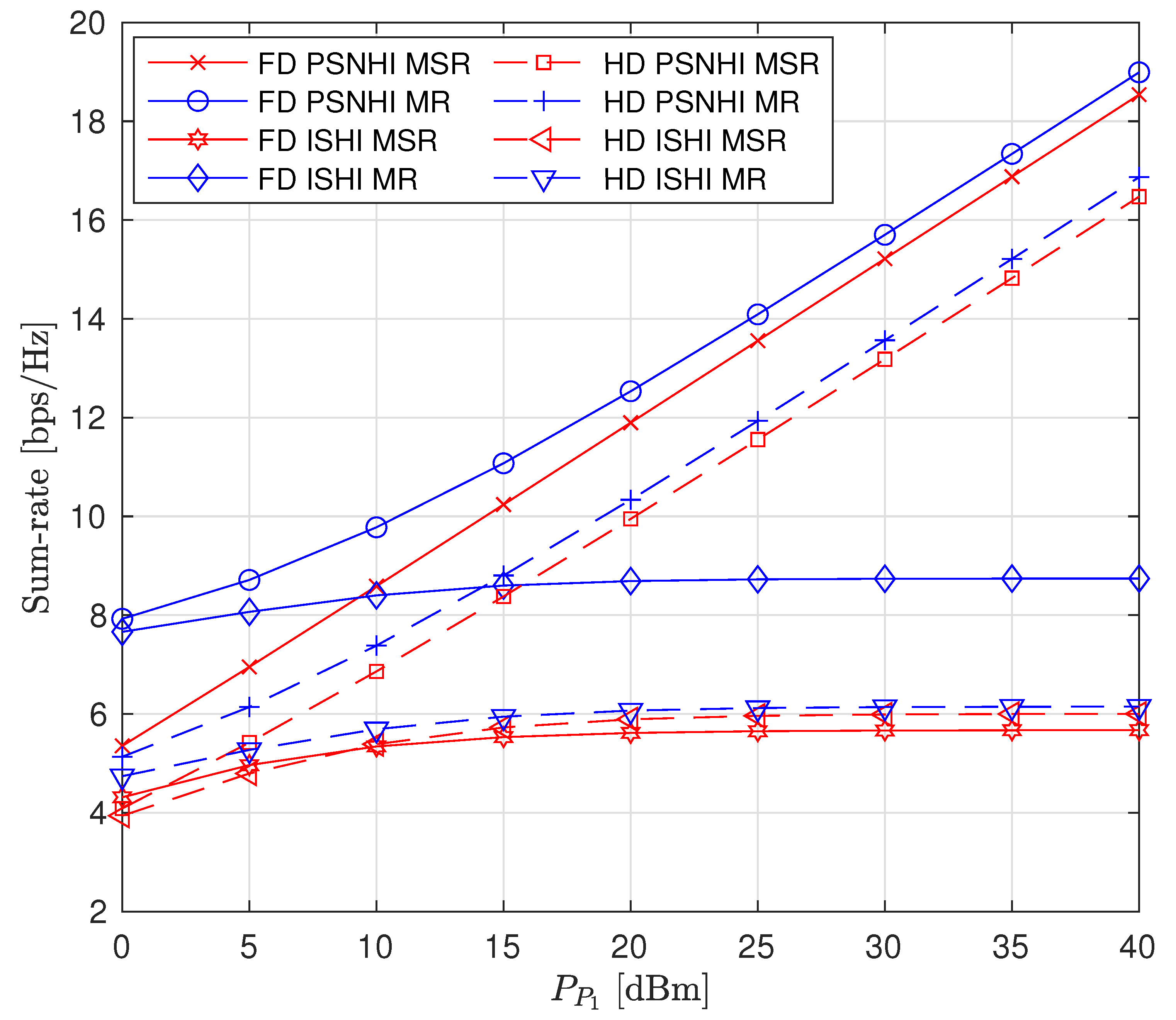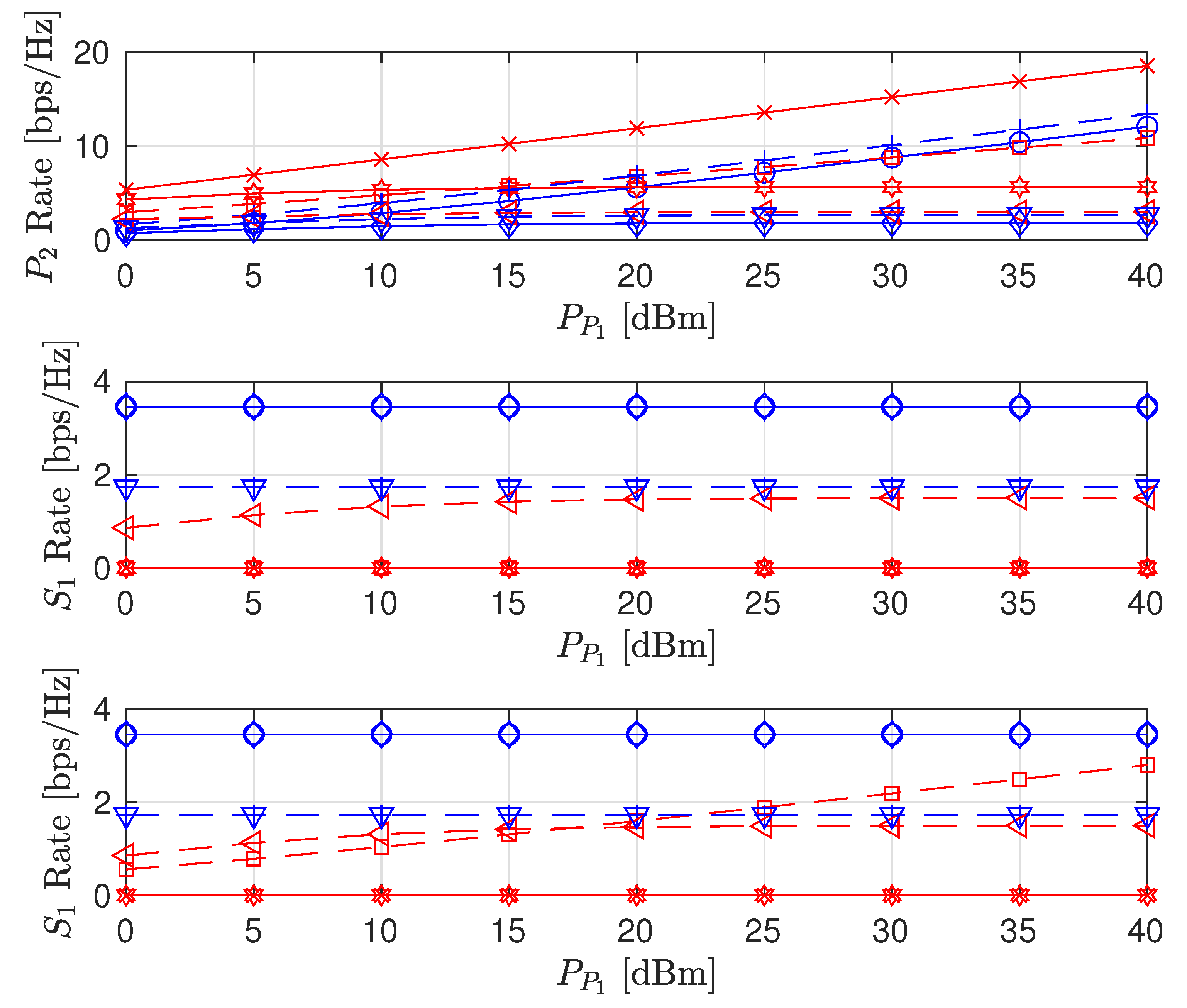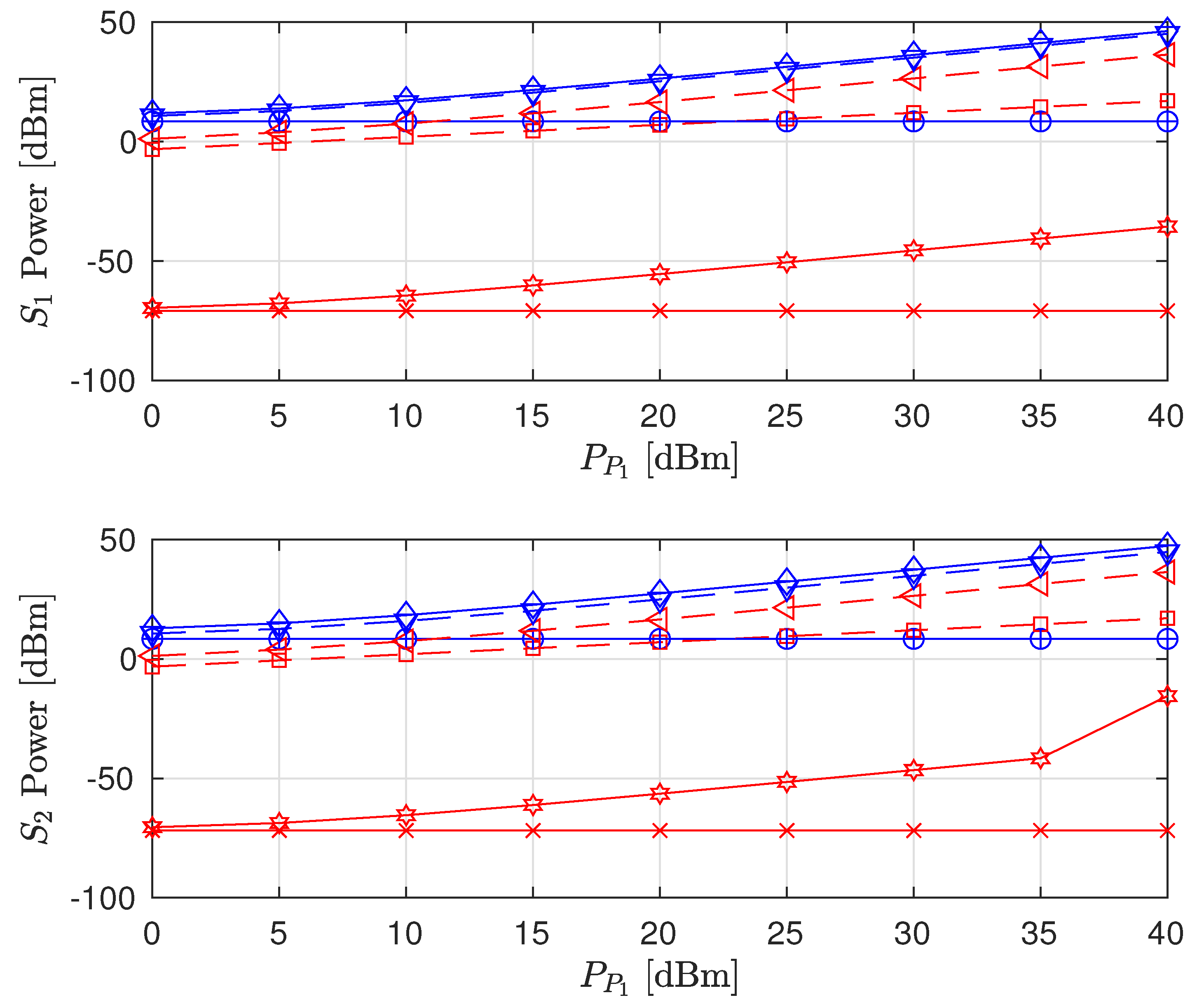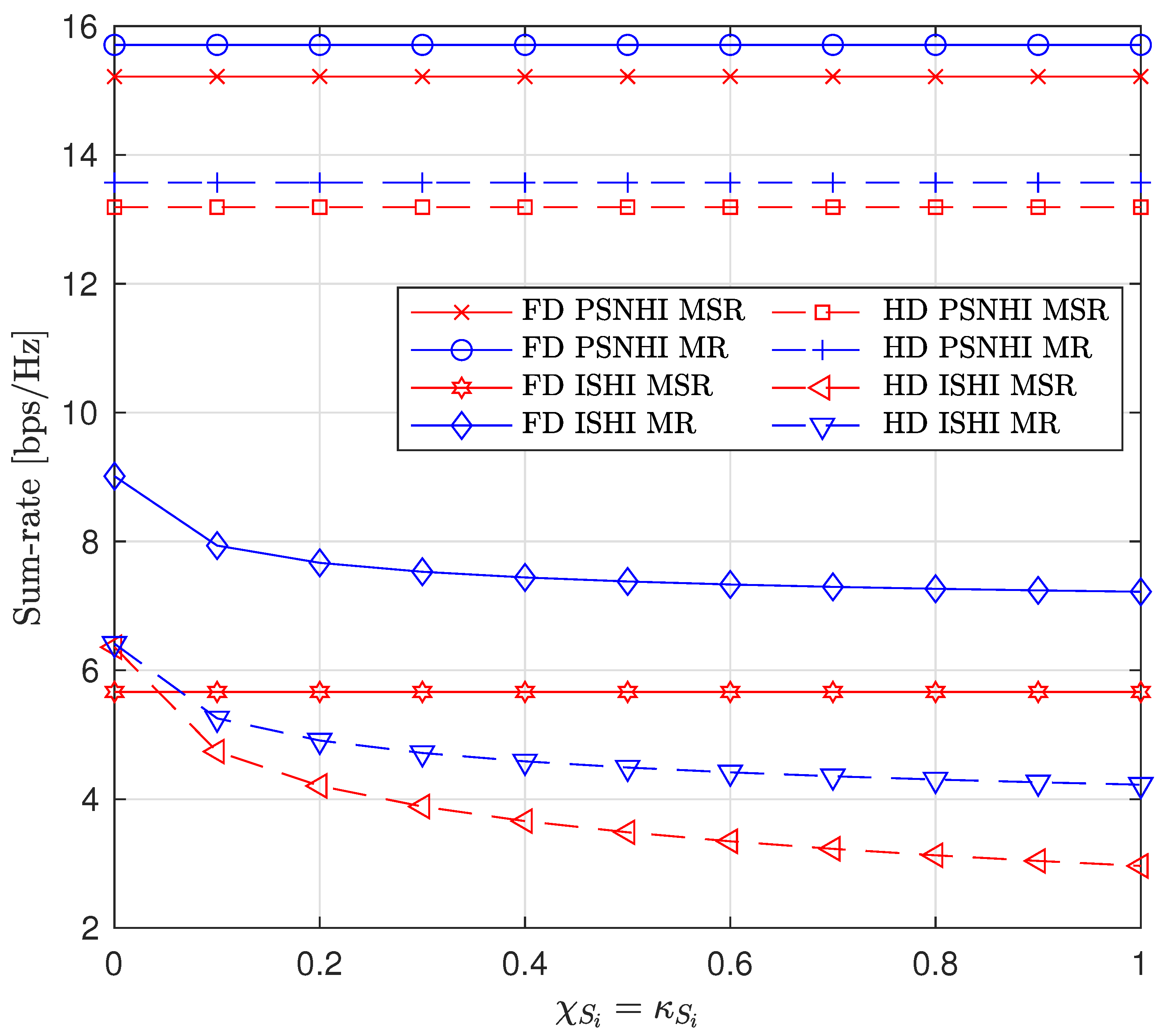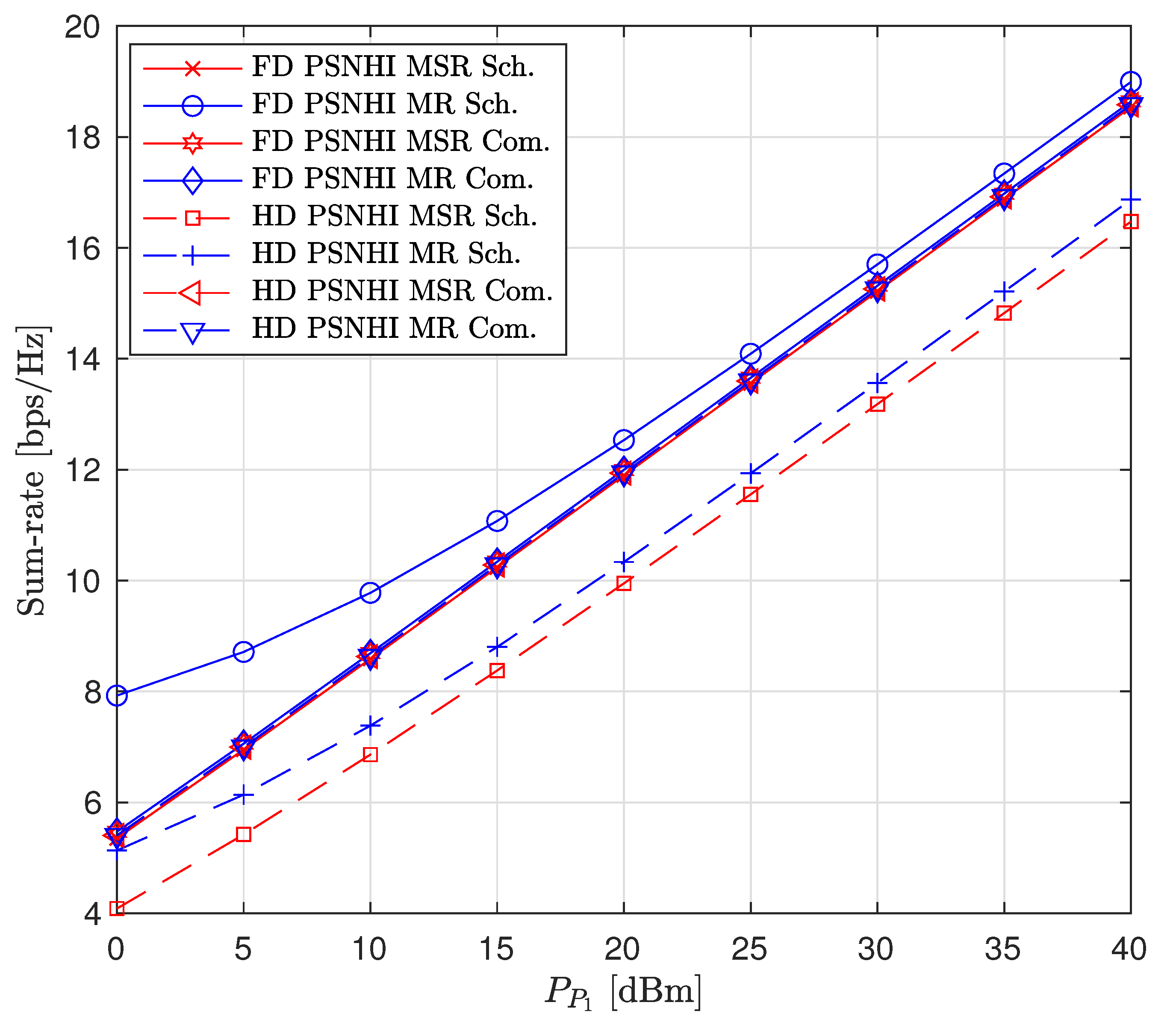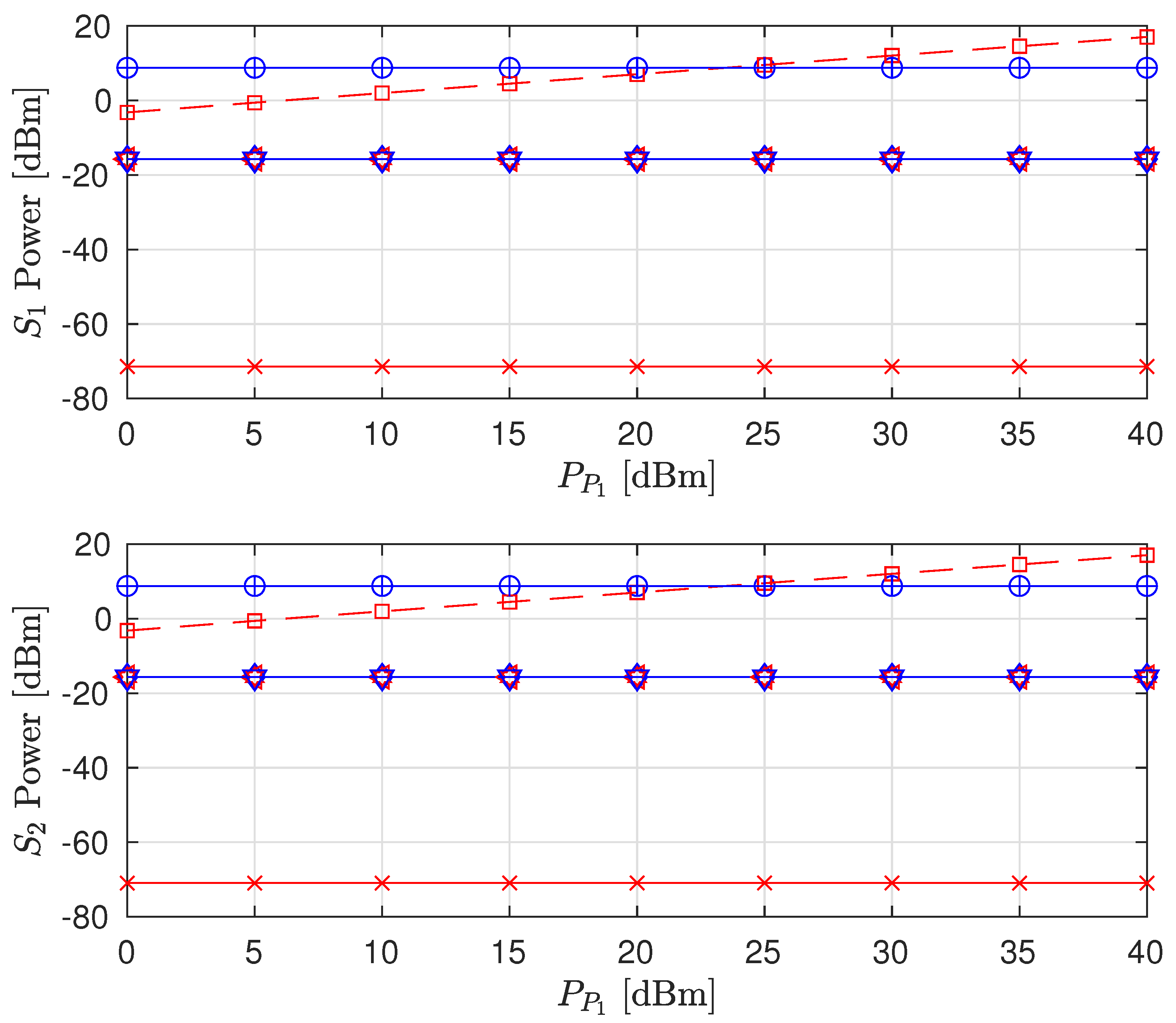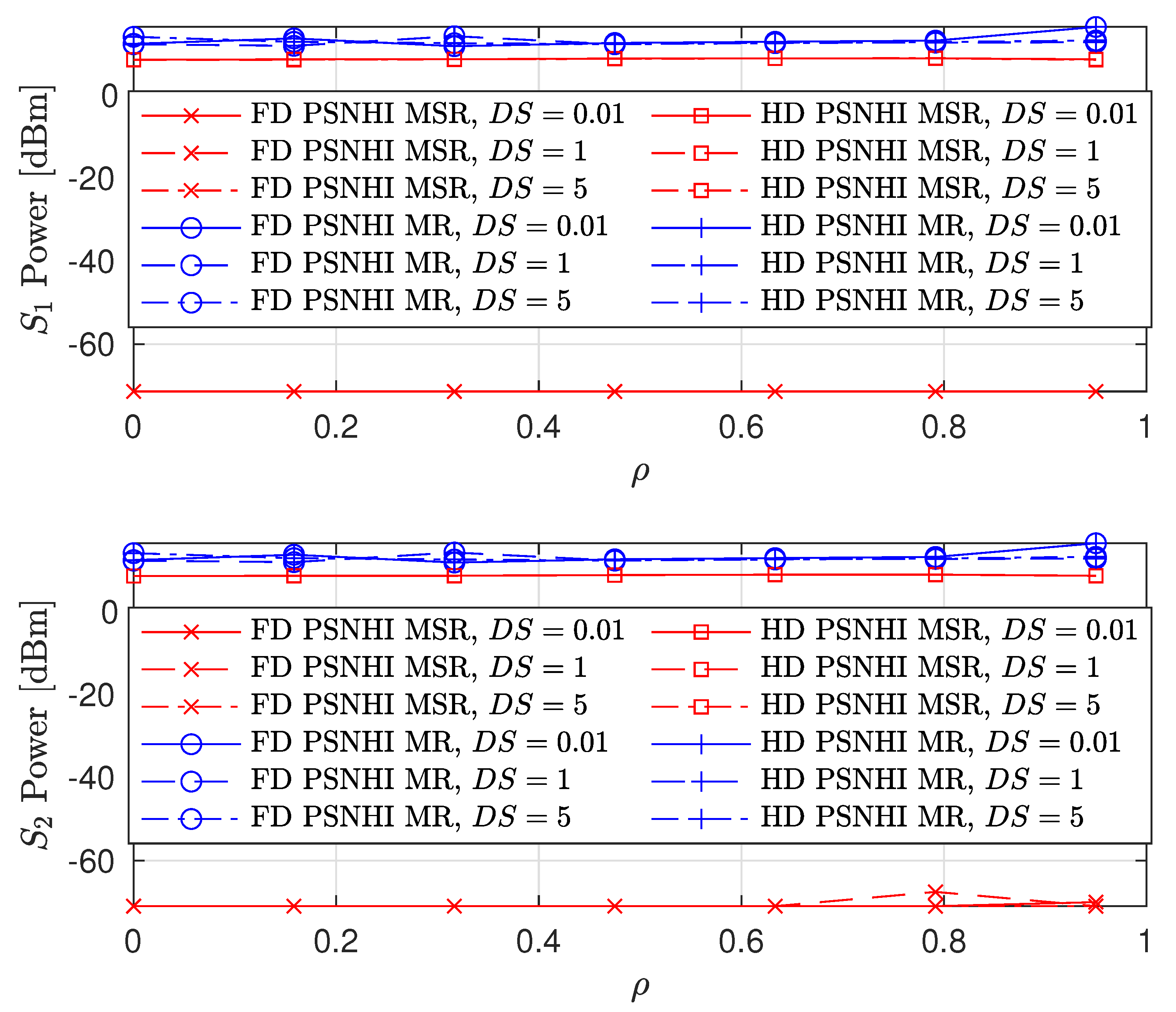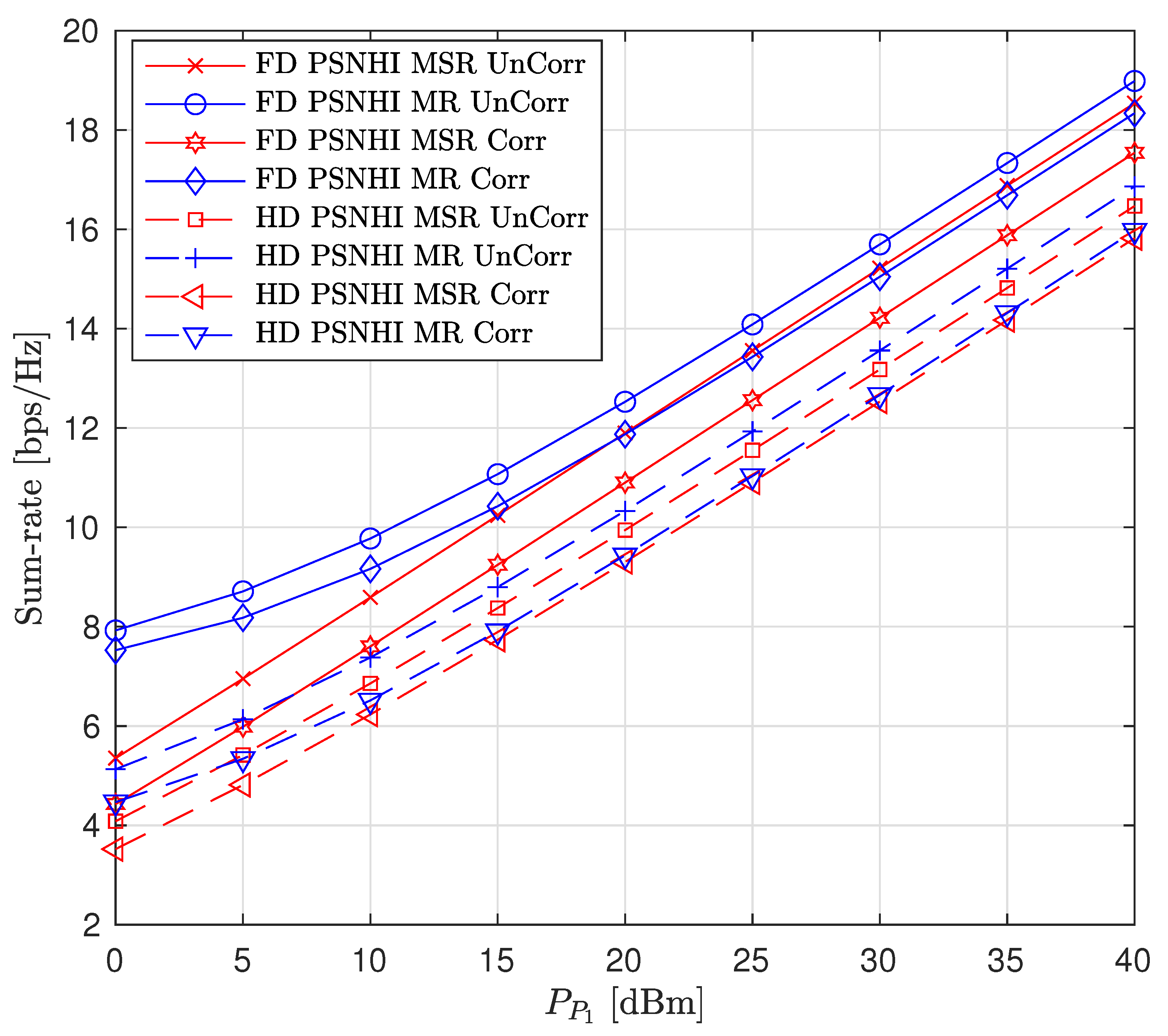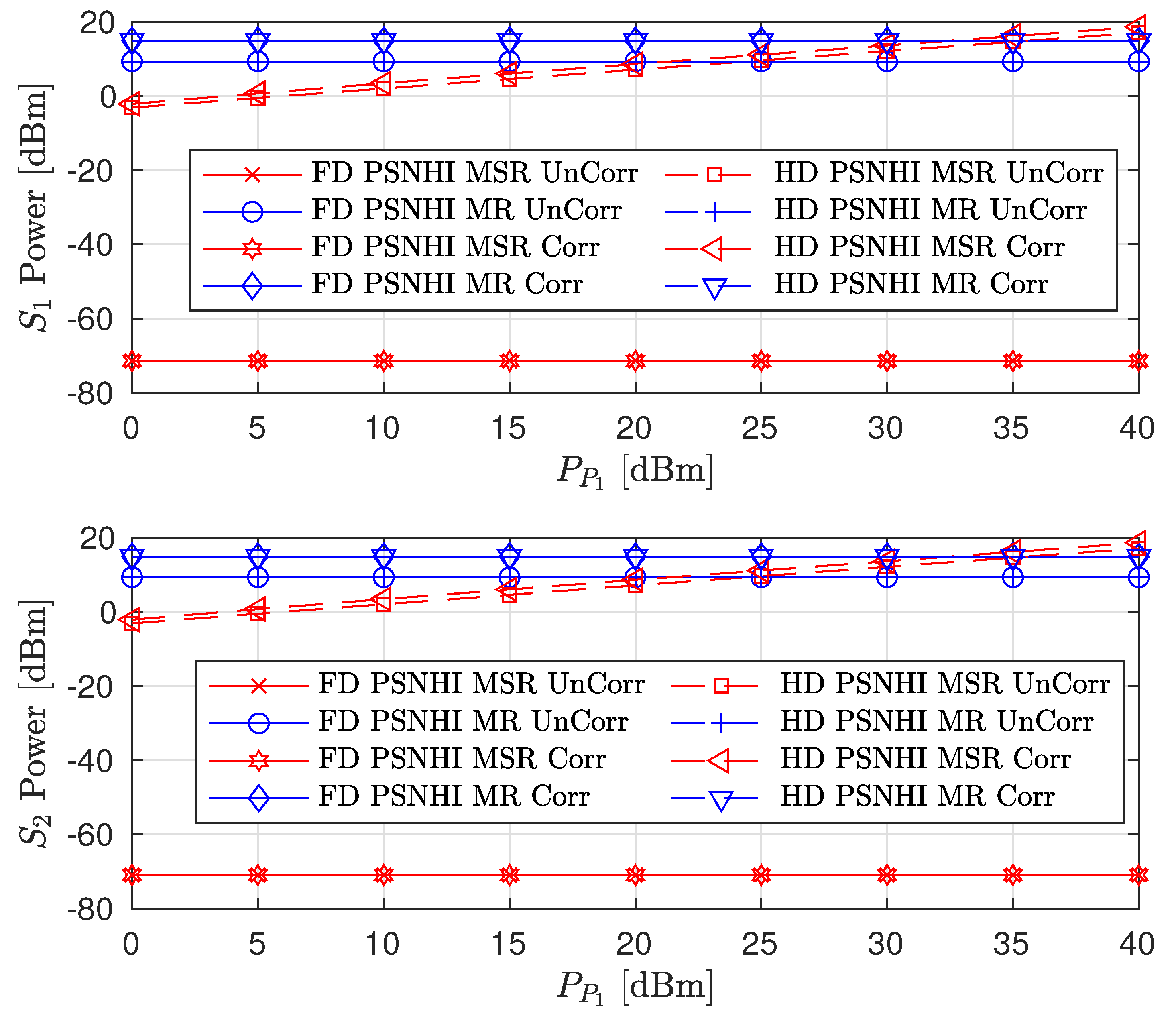1. Introduction
Cognitive radio (CR) is shifting spectrum usage from fixed allocation to the sharing/exploration of new spectrum resources [
1]. Spectrum resources are efficiently used in the CR framework (CRF) by employing spectrum sensing or power allocation [
2,
3,
4]. Backscatter communication (BC) technology, in which devices transmit data by backscattering waves from radio transmitters, has also emerged to support the realization of ultra-low-power and ultra-low-cost devices [
5,
6,
7,
8]. Recently, attempts have been made to combine CRF and BC technology in two different approaches: (1) BC-based secondary transmission [
9,
10,
11,
12,
13] and (2) BC-aided secondary transmission [
14,
15,
16,
17]. In particular, the BC-aided approach improves the performance of not only secondary transmission but also primary transmission if the power resources are properly allocated; thus, this approach is also referred to as the
symbiotic radio approach [
1] due to the diversity gain achieved through the additional communication path using a BC device.
Most studies on BC-aided secondary transmission have focused on a half-duplex (HD) secondary link (SL) [
14,
16,
17,
18]. With the advent of single-channel, full-duplex (FD) communication technology, FD- and BC-based SLs have been evaluated in several research works [
11,
13]. However, FD-based, BC-aided SLs have not yet been explored in the literature. Since the adoption of FD communication in combination with a BC-aided SL prompted the creation of new interference scenarios, this new type of system needs exploration. Currently, it is known that imperfect self-interference cancellation (SIC) and other hardware impairments (HIs) [
19,
20] greatly affect the performance of FD communication, and it is important to consider them in resource allocation [
11,
13,
21,
22].
Since FD-based, BC-aided, SL transmission has not been considered in existing BC-aided transmission research, the effects and influence of hardware impairments, including imperfect SIC, have not been studied either in the CRF with FD-based, BC-aided, and SL transmission. Moreover, communicating devices have other imperfections within their hardware [
19], which are introduced in devices due to amplifier non-linearity, in-phase/quadrature imbalance, quantization error, etc. [
20]. Hence, HIs must be considered within the CRF with BC-aided transmission. However, HIs have not been explored in the CRF with BC-aided transmission [
14,
16,
18]. In addition to HIs, power resources must be efficiently allocated to improve the CRF performance. However, most BC-aided transmission research (e.g., [
16]) has focused on a system analysis. In [
14], the authors considered the power resource allocation optimization of BC-aided transmission; however, this is HD without HI. Therefore, the power resource optimization problem for FD-based, BC-aided transmission in the CRF with HIs needs to be investigated.
In this paper, we solve the power resource optimization problem for the new CRF with a symbiotic, FD-based, BC-aided SL protecting a primary link (PL), considering HIs for the nodes of both links. In the proposed CRF, the SL consists of two FD nodes that simultaneously transmit to each other. On both the PL and SL, information is sent via a direct link and a BC-aided tag link. We consider various HI cases: imperfect SIC (Imp-SIC), imperfect successive interference cancellation (Imp-SuIC), and other HIs causing signal distortion and channel estimation error. The power resource optimization problem is solved using two approaches with different objectives: (a) maximizing the sum rate (MSR) and (b) maximizing the PL rate subject to rate constraints on the SL (MR). The solution for the FD mode is obtained with a simple root-finding algorithm, while that for the HD mode is derived in a closed form. Through simulation, we show that the sum rate and the exploitation of the FD capability of the SL are strongly affected by both the problem objective and HIs.
The remainder of the paper is organized as follows. Recent studies related to this work are reviewed and discussed in
Section 2. The system model under consideration is introduced in
Section 3.
Section 4 presents an optimization solution with FD transmission, and
Section 5 presents it with HD transmission.
Section 6 presents the performance evaluation, and
Section 7 concludes the paper.
Notations: is the expectation of the random variable X. defines a circularly additive white Gaussian noise (AWGN) variable with a mean of zero and a variance of .
2. Related Work
In this section, the related works focus on BC, unidirectional (one-way) and bidirectional (two-way) FD and HD communication systems. A time-sharing HD CRF between PL transmission and BC-aided SL transmission is presented in [
23]. The authors proposed time and power allocation schemes to optimize the transmission rates for the unidirectional, HD, CRF system. Another unidirectional, BC-aided, SL transmission is considered in [
16]. The work focused on analyzing the influence of the SL signal interference in the PL communication. The authors in [
24] focused on analyzing the capacities of an HD, unidirectional system consisting of a combination of SL, BC-transmission and BC-aided, PL transmission in their research. A unidirectional, SL, BC-transmission system is discussed in [
25]. The authors considered both the equal symbol period and unequal symbol period between the primary transmitter (PT) and the secondary transmitter (ST) and maximized the system sum rate. Outage analysis on a unidirectional BC-aided PL with energy harvesting SL are presented in [
9,
26].
In [
27], the authors presented an HD two-way BC-aided PL communication, where the two SL, BC transmitters aided two PL devices to communicate with each other. The two SL transmitters also communicate with each other. Communication between the inter-link devices occurs using HD and time division multiple access (TDMA). The authors performed outage analysis on their proposed system model. Another bidirectional BC communication system is analyzed in [
17] where a hybrid relay (BC transmitter and data relay) aids communication between two PL devices. The hybrid relay acts as a BC-aided transmission device for the two PL devices and acts as a BC-transmission device to achieve BC between its data and the two PL devices. An energy harvesting TDMA HD bi-directional BC-transmission communication system is investigated in [
28]. In their system model, the access point (AP) transmits energy and data in two different time slots and receives backscattered data and conventional transmission data from sensors within the network topology.
An FD, unidirectional BC-aided PL transmission is presented in [
29]. The authors considered a hybrid, FD device that decodes information and backscatters (BC-aided transmission) signals to the primary receiver. This process was conducted to improve the spectral efficiency of the primary receiver. Another FD consideration where bidirectional communication occurs for SL BC-transmission is discussed in [
11]. In [
11], an FD AP acts as the primary transmitter and secondary receiver, which transmits and collects data using TDMA. The focus of this paper was to maximize the system rate based on time resource optimization. An FD SL BC-transmission system is presented in [
30]. In [
30], the FD, secondary AP transmits energy signals and receives BC data transmission from the secondary users. Both the PL and SL cause interference with each other. The authors seek to maximize the CRF sum rate.
As evident by the related works discussed, most papers concentrate on HD and unidirectional BC-(transmission-aided) PL and SL communications [
9,
16,
23,
24,
25,
26]. Fewer of these studies focus on unidirectional FD-based BC PL, and SL communication [
11,
29,
30]. Concerning bidirectional BC PL, and SL communication, [
17,
27,
28] considered BC-aided (transmission-aided) HD, PL, and SL communication. Research on bidirectional FD BC-aided and BC-transmission communication have not been considered in research.
3. System Model
A BC-aided CRF consisting of a PL and an FD-based SL sharing a spectrum band is illustrated in
Figure 1. The PL consists of a transmitter
and a receiver
. The SL consists of two FD-capable STs
and
that communicate with each other. Both links transfer information over a direct link and a BC link facilitated by a BC tag
T. The tag BC link helps improve the spectral efficiency of both the PL and SL due to improvement in diversity gain [
1]. Unlike [
16], we consider non-negligible interference with the SL introduced by
for a more realistic deployment scenario.
suffers interference from the nearby STs and tag. Imp-SIC (for the cancellation of self-interference) and Imp-SuIC (for the cancellation of the interference from
) are considered for
and
, while the other HIs resulting in signal distortion and channel estimation error are considered for all nodes, including
and
. The internode channels are depicted and defined in
Figure 1. Channel reciprocity is assumed since all communication paths are established in the same frequency band.
,
, and
are the transmit power levels of
,
, and
, respectively, and
,
, and
are their maximum values. The transmitted signal
is assumed to satisfy
(
, where
t represents the tag
T).
(
) is the BC signal attenuation factor.
The received signal at
is obtained as
where
is the distortion noise of a received signal on a directional link from node
to node
(where
and
may represent
,
,
, or
), the variance of which is defined as
. The antenna noise at node
z (
,
or
) is defined as
. The received signals at the STs are given by
where
;
is the distortion noise of a self-interference signal present at node
z (
or
), with variance
, and
is the estimated signal of
.
6. Simulation Results and Discussion
In this section, simulation results comparing the FD and HD modes of the SL are presented. Two HI scenarios (PSNHI and ISHI) are considered in addition to varying channel estimation errors. The node-to-node (
-to-
) channels are modeled as
, while the tag-to-node channels are modeled as
[
22] where
is the internode distance. The small-scale fading is defined as Rayleigh fading, of the form
. (Unless specified otherwise, we consider uncorrelated Rayleigh fading channels.)
The nodes (i.e., PT, PR, and STs) are randomly distributed within a specified radius from the BC tag, as shown in the example in
Figure 2. Unless specified otherwise, the parameter values utilized for simulation are those listed in
Table 1. The results presented are achieved over
random channel generations.
The effects of increasing
on the sum rate (i.e.,
), individual node rates and the transmit power levels of the STs are shown in
Figure 3,
Figure 4 and
Figure 5, respectively (The legends are the same for all plots; thus, they are not shown on all plots for graph visibility.). First, we compare the MSR and MR approaches. In
Figure 3, the MR approach outperforms the MSR approach for both the PSNHI and ISHI scenarios in terms of the sum rate. This observation can be explained by
Figure 4, where it is seen that the STs achieve insignificant rate values under the MSR approach because they are forced to use little power to reduce the interference at
, as shown in
Figure 5. In contrast, the MR approach allows the STs to use higher transmit power to satisfy their rate constraints, as shown in
Figure 4. Second, we compare the FD and HD modes for the different approaches and HI scenarios. As shown in
Figure 3, under the MR approach, the FD mode achieves better sum rates than the HD mode in both considered HI scenarios. This result occurs with similar transmit power levels between the STs for both modes, as shown in
Figure 5, although the
and
rates are almost doubled in the FD mode due to simultaneous transmission and reception, as observed in
Figure 4. However, the MSR approach cannot take advantage of the benefits of the FD mode since the goal of this approach is to minimize the interference from
and
at
, thereby maximizing
instead of concurrently maximizing
and
. Note that the transmit power of
is given, while the transmit power levels of
and
are determined reactively and thus, are set to be insignificant in the MSR approach. This finding is confirmed by the SL transmit power levels and rates in
Figure 4 and
Figure 5, respectively. In particular, in the ISHI scenario, the FD mode achieves a lower sum rate than the HD mode because the system imperfections require the STs to use higher transmit power to increase their rates, which increases the interference affecting
. Under the MSR approach in the PSNHI scenario, the FD mode outperforms the HD mode because
attains a larger rate in the former compared to the latter because the SL interference power is minimal in the FD mode. Notably, sum-rate saturation is observed in
Figure 3 for both the FD and HD modes in the ISHI scenario due to an excessive interference-and-noise sum resulting from
’s interference, the residual interference after cancellation and other HIs.
Next, we investigate the effects of imperfect cancellation (Imp-SIC and Imp-SuIC) and channel estimation error on the sum rate by varying the HI coefficients
,
, and
(we assume that
). First, the effect of varying
and
is shown in
Figure 6. In the PSNHI scenario, the sum-rate values are constant because the SIC and SuIC are perfect. In the ISHI scenario, the sum rate decreases with an increase in imperfection coefficients. However, the FD sum rate is constant under the MSR approach because of the STs’ insignificant rate values, and thus, the sum rate mainly consists of the
rate and is not affected by either SIC or SuIC in this case. Second, the effect of imperfect CSI on the sum rate is shown in
Figure 7. The small-scale channel model for imperfect CSI is
, where
and
are the estimated and error channels, respectively, with a variance of
[
22]. Under both the MR and MSR approaches, the sum rate significantly decreases with an increase in
in the PSNHI scenario. However, only a minute decrease in the sum-rate value is seen in the ISHI scenario due to the HIs present in the ISHI scenario, which already have a significant impact on the sum rate. Thus, the effect of
on top of the HIs is negligible.
A comparison of our proposed scheme (Sch) to the naive (Com) fixed interference power (
dBm and
) [
16] and fixed time allocation factor (
) for the PSNHI system structure are presented in
Figure 8,
Figure 9 and
Figure 10. The MSR and MR sum-rates for both the Sch and Com improve with an increase in
, as shown in
Figure 8. The increase in sum rates is mainly attributed to the rates achieved by the PL. In
Figure 8, due to the constant
and
in the Com benchmark scheme, the MSR and MR have similar performances. However, the Com benchmark scheme underperforms the FD MR Sch. because the optimal interference power is determined in the FD MR Sch., producing better rates for the STs (shown in
Figure 9), which improve the sum rate of the system. The MSR and MR sum rates for the Com benchmark scheme are suboptimal. However, their performances are similar to the FD MSR Sch because the FD MSR Sch approach achieves meager interference power (shown in
Figure 10). Therefore, the FD MSR Sch approach obtains lower STs rates (
Figure 9) and lower sum rates (
Figure 8).
We also consider the influence of time and spatial correlation in Rayleigh fading channels on sum-rate, PL and SL rates, and the STs transmit power as presented in
Figure 11,
Figure 12 and
Figure 13, respectively. For time domain correlation, we consider various Doppler shift (DS) values. The spatial correlation of channels is parameterized by their covariance which we denote by
[
31]. It can be observed from all the figures that the time correlation does not affect the performance of the algorithm. This is because the proposed algorithm makes a decision in a per-frame basis and we assume that a channel remains static during a frame time. However, the spatial correlation (increasing covariance) influences the performance of the algorithms and achieved values. The sum-rates of FD PSNHI MR and HD PSNHI MSR improve as the spatial correlation increases. Since more channels are involved in the FD system, both PL and SL benefit from spatial correlation higher in the FD system than the HD system. Hence, there is an improvement in the SL and PL rates achieved in the FD system compared to the HD system. FD MSR and FD MR have insignificant and significant increases, respectively, as shown in
Figure 9. This causes a noticeable increase in the FD MR plot in
Figure 11. With the HD system, STs’ transmission occur in two different time slots while PL transmission occurs in both time slots. Thus, there is a channel correlation between the PL and SL in each time slot. This implies that each ST has a better channel correlation with the PL system in a particular time slot. Therefore, the STs improve their rates compared to the PL, which shares two different correlated channels with two STs in two different time slots. This leads to the reduction in the PL rates for the MSR scheme, as shown in
Figure 9. However, due to the rate constraints on the STs in the MR scheme, the PL can maintain its rate performance.
Finally, the performance comparison of the proposed CRF between correlated (Corr) and uncorrelated (UnCorr) Rayleigh fading channels is discussed. For time domain correlation, we consider a channel sampling rate of 50 Hz and a Doppler shift (DS) of 5 Hz. For spatial correlation of channels, we set
to 0.95. The comparison results are given in
Figure 14,
Figure 15 and
Figure 16. For the sum-rate plot in
Figure 14, the UnCorr case performs better than the Corr channel case. This is because the Corr channels are a scaled version of the UnCorr channels by the correlation factor. This implies that the Corr has lower channel gains compared to the UnCorr channel if
. Therefore, in the Corr channel case, STs use higher transmit powers compared to the Uncorr channel case, as seen in
Figure 16. Even though the Corr case transmits with higher power, it achieves the same rate values and constraints for the SL between Corr and Uncorr, as shown in
Figure 15. However, the higher SL transmit power of the Corr case leads to higher interference power at the PL, leading to the Corr achieving a lower PL rate compared to the UnCorr case as presented in
Figure 15. This behavior is transferred to the sum-rate plots in
Figure 14 where the UnCorr case has better performance compared to the Corr case because of the PL rate performance difference.


